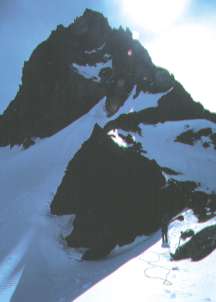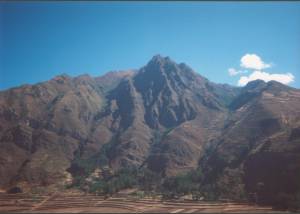Every month, we'd like to feature one of your photos from anywhere in the world and invite other readers to guess where it was taken. Look every month in the print Geotimes for a new photo. Following are clues, answers and winners from past issues.

| Geotimes Home | Calendar | Classifieds | Subscribe | Advertise |
| Geotimes
Published by the American Geological Institute |
December
2000
Newsmagazine of the Earth Sciences |
| Do you have slides and photos
you've collected from field work or vacations?
Every month, we'd like to feature one of your photos from anywhere in the world and invite other readers to guess where it was taken. Look every month in the print Geotimes for a new photo. Following are clues, answers and winners from past issues. |
 |
| The first three readers
to identify the location pictured in the current print version of Geotimes
receive a Brunton 8099 EclipseTM
compass and the first 10 will receive a Where on Earth? T-shirt.
Please note that all contestants are eligible to win one compass per year.
Click here
to submit a guess for this month's Where on Earth?
contest.
Submit
photos for Where on Earth?
|
 |
Clues:
1. Although under 2,500 meters high, this glacier-covered peak would make a chilly home for the gods. Areas of an adjacent rain forest receive an average of 167 inches of rain a year. 2. Rocks in this Cenozoic subduction comples range in age from 55 million years to 15 million years. 3. The first systematic exploration of the interior of this range took place in 1885. Scroll down for the answer ... |
| Answer:
Mt. Olympus, Wash. |
November winners:
Erin Sutton — Leesburg, Va.
Joe Michaletz — Helena, Mont.
Bruce Bryant —
Tom Rinehart —
Fred Hawkins — Denver, Colo.
Mauri Pelto — Dudley, Mass.
Paul Butler — Olympia, Wash.
Stephen Lee — Newbury Park, Calif.
Rob Viens — Bellevue, Wash.
Gwyneth Jones — Seattle, Wash.
 |
Clues:
1. An interannual climate phenomenon brought severe floods and landslides to this valley in 1998, claiming many lives and destroying a hydroelectric plant. 2. Within one 100-mile section of this mountain belt, the vertical distance between its high peaks and the bottom of the subduction trench offshore is as much as 14,000 meters (47,000 feet). 3. Tucked away in this mountain is an important archeaological site, one of many that dot the entire valley, which terminates at the remains of an ancient city forgotten until discovered by an archeologist in 1911. Scroll down for the answer ... |
| Answer:
This mountain overlooks the colonial city of Pisac in south-central Peru's Urubamba valley, named for the river flowing through it. Also called the Sacred Valley, it was important to the Inca and houses many Inca ruins, including the ruins of Pisac, nestled behind this mountain, and the well-known city of Machu Picchu, which sits at the valley's northern end. |
October winners:
George Dasher — Elkview, WV
David King — Auburn, Ala.
David Keating —
Ryan Christiansen. — DeKalb, Ill.
Paul Butler — Olympia, Was.
Mauri Pelto — Dudley, Mass.
Jim Humphrey — Midland, Tex.
Michael Siemens — Rolla, Mo.
Jeff Amato — LasCruces, N.M.
Seigfried Hamann — Huntington Beach, Calif.